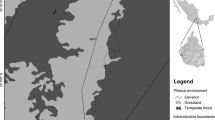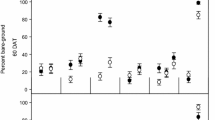Abstract
Imperata cylindrica is an important component of grasslands in several Asian countries. Its vigorous rhizome elongation enables the plant to quickly cover bare ground, making it a candidate for revegetation projects. In these projects, initial and subsequent management practices often differ. Initial management strategies are important for encouraging rapid cover by the target species. We tested the effects of initial hand weeding on I. cylindrica cover and weed growth over 2 years. Two types of soil (A and B) were scattered on a recently constructed river embankment at a depth of 10 cm. Both soils A and B are nutrient-poor and high (> 7.0) pH. Plots were hand-weeded once or twice a year (W1 and W2 treatments, respectively), or mowed but not weeded (M treatment) with four replications. Plug plants of I. cylindrica were introduced. I. cylindrica became dominant in soil A with the W2 treatment, with 50% cover in year 2. Conversely, I. cylindrica failed to establish in soil B regardless of treatment, due to dominance of the weed Sorghum halepense. Soil B included creeping rhizomes of S. halepense, and vigorous growth from rhizomes is likely a major reason for its predominance. S. halepense seedlings germinated in both soils, but were successfully eradicated when weeded at less than 1 month of age. Thus, for successful revegetation, land managers should use soil that does not contain creeping rhizomes of S. halepense. If rhizomes are not present, hand weeding twice a year for 2 years is sufficient for establishment of I. cylindrica.



Similar content being viewed by others
References
Aizawa A, Tanaka A, Kobayashi H, Kobayashi T (2015) Evaluation for the effect of alien plants of the indigenous grassland community on the river bank of the Tone canal. J Jpn Soc Revegetn Technol 40:527–533 (in Japanese with English summary)
Andrés P, Jorba M (2000) Mitigation strategies in some motorway embankments (Catalonia, Spain). Restor Ecol 8:268–275
Andrés P, Zapater V, Pamplona M (1996) Stabilization of motorway slopes with herbaceous cover, Catalonia, Spain. Restor Ecol 4:51–60
Asami K, Hattori T, Akamatsu H (1995) A study on management by cutting of the embankment vegetation. Jpn J Landsc Archit 58:125–128 (in Japanese with English summary)
Bochet E, Tormo J, García-Fayos P (2010) Native species for roadslope revegetation: selection, validation, and cost effectiveness. Restor Ecol 18:656–663
Brindle FA (2003) Use of native vegetation and biostimulants for controlling soil erosion on steep terrain. J Transp Res Board Eighth Int Conf Low Vol Roads 1:203–209
Bullock JM, Aronson J, Newton AC, Pywell RF, Rey-Benayas JM (2011) Restoration of ecosystem services and biodiversity: conflicts and opportunities. Trends Ecol Evolut 26:541–549
Chigaya-Sougen-Soushutu-Kenkyukai (2000) Chigayasougen-soushutsu-no-tebiki. Ministry of Construction Japan, Hyogo (in Japanese)
Ezaki T, Sakurai Y (1992) Standing crop and strength of root system of trees and grasses for landscaping. Jpn J Landsc Archit 55:181–186 (in Japanese with English summary)
Ezaki T, Inoue S, Kohno S, Fujihisa M, Iwamoto T, Chun K (2004) Planting density and standing crop of Imperata cylindrica. J Weed Sci (suppl) 49:140–141 (in Japanese)
Gray DH, Leiser AT (1982) Biotechnical slope protection and erosion control. Van Nostrand Reinhold Company, New York, p 271
Hattori A, Mochizuki T, Fujita K (1997) Estimation of erosion resistance of the levee slopes covered by vegetation which is managed by two cuttings per year. Proc Hydraul Eng 41:367–372 (in Japanese with English summary)
Hilvers G, Hopkinson L, Davis E (2017) Evaluation of revegetation techniques for roadside construction sites. J Environ Eng Landsc Manag 25:305–315
Hiradate S, Kusumoto Y, Morita S (2008) Relationships between invasion of exotic plant species and soil pH and soil available P. Research products of NIAES in 2008. https://www.naro.affrc.go.jp/archive/niaes/sinfo/result/result25/result25_30.pdf. Accessed 4 Mar 2019
Huang WZ, Hsiao AI (1987) Factors affecting seed dormancy and germination of Johnsongrass, Sorghum halepense (L.) Pers. Weed Res 27:1–12
Japan Meteorological Agency (2019) The past meteorological data in Japan. https://www.data.jma.go.jp/obd/stats/etrn/index.php. Accessed 4 Mar 2019
Kitazawa T, Ohsawa M (2002) Patterns of species diversity in rural herbaceous communities under different management regimes, Chiba, central Japan. Biol Conserv 104:239–249
Korres NE, Norsworthy JK, Brye KR, Skinner JRV, Mauromoustakos A (2017) Relationships between soil properties and the occurrence of the most agronomically important weed species in the field margins of eastern Arkansas—implications for weed management in field margins. Weed Res 57:159–171
Koyanagi TF, Yamada S, Matsuzaki H, Kato Y (2019) Impacts of previous maintenance of river embankments on the grassland communities by changing soil properties. Ecol Eng 131:73–80
Lee HJ, Nakagoshi N (2010) Grassland vegetation change after riverbank restoration in Jungnang River, Seoul, Korea. Hikobia 15:377–384
MacDonald GE (2004) Cogongrass (Imperata cylindrica): biology, ecology, and management. Crit Rev Plant Sci 23:367–380
Majumdar S, Snwal U (2017) Interference potential of Sorghum halepense on soil and plant seedling growth. Plant Soil 418:219–230
Martínez-Ruiz C, Fernández-Santos B, Putwain PD, Fernández-Gómez MJ (2007) Natural and man-induced revegetation on mining wastes: changes in the floristic composition during early succession. Ecol Eng 30:286–294
McWhorter CG (1961) Morphology and development of johnsongrass plants from seeds and rhizomes. Weeds 9:558–562
Monaghan N (1979) The biology of Johnson grass (Sorghum halepense). Weed Res 19:261–267
Neldner VJ, Fensham RJ, Clarkson JR, Stanton JP (1997) The natural grasslands of Cape York Peninsula, Australia: description, distribution and conservation status. Biol Conserv 81:121–136
Numata M, Yoshizawa N (eds) (1979) Weed flora of Japan. Nippon-shokubutsuchouseizai-kenkyukyokai, Tokyo (in Japanese)
Peet NB, Watkinson AR, Bell DJ, Kattel BJ (1999) Plant diversity in the threatened sub-tropical grasslands of Nepal. Biol Conserv 88:193–206
Pywell RF, Bullock JM, Hopkins A, Walker KJ, Sparks TH, Burke MJW, Peel S (2002) Restoration of species-rich grassland on arable land: assessing the limiting process using a multi-site experiment. J Appl Ecol 39:294–309
R Core Team (2015) R: A language and environment for statistical computing. R Foundation for Statistical Computing, Vienna. http://www.Rproject org/
Scotton M, Goliński P, Baasch A, Tischew S (2012) Management options and monitoring of restoration success. In: Scotton M, Kirmer A, Krautzer B (eds) Practical handbook for seed harvest and ecological restoration of species-rich grasslands. Cleup, Padova, pp 59–64
Stevenson MJ, Bullock JM, Ward LK (1995) Re-creating semi-natural communities: effect of sowing rate on establishment of calcareous grassland. Restor Ecol 3:279–289
Tinsley MJ, Simmons MT, Windhager S (2006) The establishment success of native versus non-native herbaceous seed mixes on a revegetated roadside in Central Texas. Ecol Eng 26:231–240
Tomizawa M, Washitani I (1998) Response of Eupatrium fortunei and Solidago altissima L. to summer loss of above ground parts: a study for planning restored vegetation management. Jpn J Conserv Ecol 3:57–67
Tormo J, Bochet E, García-Fayos P (2007) Roadfill revegetation in semiarid Mediterranean environments. Part II: topsoiling, species selection, and hydroseeding. Restor Ecol 15:97–102
Török P, Deák B, Vida E, Valkó O, Lengyel S, Tóthmérész B (2010) Restoring grassland diversity: sowing low-diversity seed mixtures can lead to rapid favorable changes. Biol Conserv 143:806–812
Umami N, Gondo T, Tanaka H, Rahman MM, Akashi R (2012) Efficient nursery plant production of dwarf cogongrass (Imperata cylindrica L.) through mass propagation in liquid culture. Grassl Sci 58:201–207
Walker KJ, Pywell RF, Warman EA, Fowbert JA, Bhogal A, Chambers BJ (2004) The importance of former land use in determining successful re-creation of lowland heath in Southern England. Biol Conserv 116:289–303
Walter AM, Chritensen S, Simmelsgaard SE (2002) Spatial correlation between weed species densities and soil properties. Weed Res 42:26–38
Yamada S, Nemoto M (2016) Effects of bare-ground revegetation techniques using Imperata cylindrica on changes in the floristic composition during early succession. Open J Ecol 6:471–483
Yamada S, Nemoto M (2017) Timing in the appearance of bare-ground is an important filter on vegetation development in a flood channel. J Jpn Soc Revegetn Technol 43:39–44 (in Japanese with English summary)
Acknowledgements
We thank members of The Arakawa Jyoryu River Office, Kanto Regional Development Bureau, Ministry of Land, Infrastructure, Transport and Tourism, Japan, for permission to conduct the study. We also thank Ms. Hiroko Sugama (Head of the Organization for the Conservation of Arakawa River) and other members of the organization for their assistance with field surveys. This research was conducted in collaboration with the River Foundation, Japan. This research was partly supported by JSPS KAKENHI Grant number JP#17H03958, and the River Fund of the River Foundation, Japan. The experiments comply with the current laws of Japan.
Author information
Authors and Affiliations
Corresponding author
Electronic supplementary material
Below is the link to the electronic supplementary material.
Rights and permissions
About this article
Cite this article
Yamada, S., Nemoto, M. Effects of weed abundance and frequency of hand weeding on the establishment of transplanted Imperata cylindrica. Landscape Ecol Eng 16, 1–9 (2020). https://doi.org/10.1007/s11355-019-00398-3
Received:
Revised:
Accepted:
Published:
Issue Date:
DOI: https://doi.org/10.1007/s11355-019-00398-3




